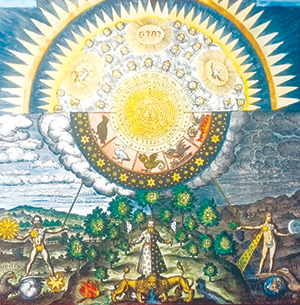Features & Columns
Alchemy for You
 SMART TABLET: This work depicts the 'Emerald Tablet of Thoth,' which alchemists believed held the secrets to ancient wisdom.
SMART TABLET: This work depicts the 'Emerald Tablet of Thoth,' which alchemists believed held the secrets to ancient wisdom.
With a fiery red-orange backdrop, the ancient art of alchemy now comes alive at the Rosicrucian Egyptian Museum. One entire room showcases this ancient art of transformation through various displays, text panels and even a replica of a medieval alchemist's workshop. A wealth of info explodes all at one time, so it can be overwhelming—as with life itself—but the dirt is in the details, so to speak.
Some background: In ancient days of yore, alchemists toiled away in their laboratories, claiming to search for methods of converting base metals into gold. Endless amounts of symbols, diagrams and texts emerged from those processes. Although their terminology contributed to the development of modern-day chemistry, people still argue over the degree to which the alchemists' methods were allegories for spiritual, mental or psychological processes. That is, when they spoke of "converting lead into gold," were they serious, or was it a metaphor for transpersonal growth? When they talked about "distilling away the contaminants," or "washing away the impurities," were they referring to actual chemical processes, or was this really about fine tuning one's own personal path (i.e. boiling away the bad elements in order to sculpt a more stable psyche)?
As early as 1500, the Rosicrucians were among the first to reiterate alchemical terminology toward a more spiritual and evolutionary direction. At least that's what Dennis Hauck told me a few years ago. He was the one who helped design the alchemy exhibit, now open to the public after years of deliberation.
Right now, the fiery-red-orange backdrop of the exhibit pulls one into the experience. Right away, visitors read an introductory explanation of alchemy and its origins in the Emerald Tablet, authored by Hermes Trismegistus, who is often interconnected with Thoth, the Egyptian god of science. From there, the fusion of western science and spiritual processes evolved all the way up to the modern conception of alchemy. Something about the ancient green hue of that tablet interacts with the red-orange-ness of the rest of the exhibit. I can't say how, but I just felt it.
And in the rest of the exhibit, one finds seven elaborate displays depicting the seven phases of alchemy: Calcination, Dissolution, Separation, Conjunction, Fermentation, Distillation and Coagulation. Each display features a main text panel, an image representing the phase in question, plus physical objects related to the phase along with additional explanatory texts offering more insight into the process.
In one case, we learn that Calcination, the first step in alchemical transformation, is a process of decomposition in which a substance is reduced to ashes or powder by heating, drying or crushing it. On a personal level, this step seeks to get beyond ego and personality to reveal one's true identity or soul.
In another example, Conjunction is a step in which two different compounds are merged to create an entirely new substance by melding, bonding, compounding, amalgamation or precipitation. On a personal level, Conjunction might be viewed as a marriage of opposites, eventually leading to a more whole and integrated being.
As one experiences the displays, reading everything in order, it is impossible not to imagine ways in which alchemy might apply to one's own journey—personally, creatively or both.
The whole process, on a micro level, could easily manifest itself as the realization of any sort of balanced inner space where opposites do not conflict with each other. If you happen to harbor a punk rock aspect of yourself that seemingly can't coexist with the easy-listening aspects of yourself, or if your urban self can't coexist with your suburban nature, then alchemy can help. With the aid of the seven phases, you can fine-tune your inner space in order to resolve conflicting elements, on your way toward becoming a more whole and integrated person.
Don't think your Black Flag records are incompatible with your Jim Nabors records. You don't have to get rid of anything. They can coexist, thanks to a few thousand years' worth of transpersonal work now illuminated by the Rosicrucian Egyptian Museum.


